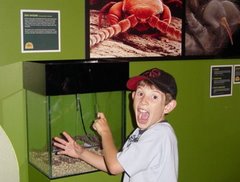Spent a few interesting days with the folks from the Museum of the Confederacy, Richmond, VA. We spoke about the kinds of questions visitors have about objects. Across a few studies now I have found rather consistent questions that keep arising for natural history and anthropological objects.
From natural history specimens people want to know:
- What is it?
- scientific name
- everyday name/description
- scientific name
- Where did it come from:
- and when was it found
- distribution
- and when was it found
- The 'museum' things:
- how is it preserved
- why is it in a museum? what is it used for?
- is it real?
- how is it preserved
- What is it related to that's familiar to me?
From anthropology objects they want to know:
- What is it made of?
- How is it used?
- What is it used for?
- How often is it used?
- What is the symbolism of it?
- How old is it?
- Is it still used today? If not, what is?
- Who were/are the people and what are their stories?
Madge showed me a document she had worked on for an art museum that had also looked at this issue. The Harvard MUSE project (Museums United with Schools in Education) suggested a framework for classifying (and therefore writing labels about) artworks which I think translate across a wide range of museums:
- Logical – how was the object made?
- Aesthetic – how does it work together with other objects?
- Narrative – what are the stories surrounding the object: social, historical and personal (I would also add perhaps scientifically for natural history objects)?
- Foundational – what are the big philosophical questions that place the object within a context?
- Experiential – what can be created in response to looking at the object (I would also add what new information, connections and meanings can be made in response to the object)?
While all the above are useful as ways of thinking about placing objects in physical exhibitions, they also have relevance I believe to how a museum might "display" their object online via their websites or through Flickr – perhaps a set of guiding principles??



3 comments:
Hi Lynda -
Definitely a good start - I think for art based works (and from my angle: moving image based works...) there are other questions about representation and creation of the object itself.
The 3D session at MW2008 raised some interesting questions on the 3D/scanning/digitisation of objects - and I think it's an interesting issue to look at as we all start to think beyond just presenting a 2D images of these objects. For moving image - it's even more complex: what does it mean to make available screen grabs, or segments, or the whole work? And in all cases - what formats should they be available in?
On the creative angle -what role do the makers of these works play in their interpretation? The session on preservation of new media explored notions of what it means to register these kinds of works in our collections - and focussed on the need for artist/creator input - this is the kind of data that will increasingly be contained in our collection databases - So I'd add something along the lines of 'creation' to these kinds of groupings - it fits somewhat into the 'foundational' label - but methinks warrants another categorisation.
Cheers,
Michael
Thanks Michael. I think your comments about representation and creation are spot on.
Some time ago we did a study with visitors about Pacific objects. We found that they really wanted to know about the meanings behind the objects in terms of cultural, spiritual, historical and personal meanings. In this case the object makers' stories (such as a community member) were of primary interest and with the more readily available technologies, such as sound recorders, these kinds of intangible aspects are much easier to capture and, therefore, make widely available.
Regarding the Museums and the Web papers I'm assuming you're referring to the following(have embedded links for others to find):
* New Media Art in Museum Collections
* Ethnographic Methods and New Media Preservation
...and the 3D one from from a mini-workshop - paper here
Post a Comment